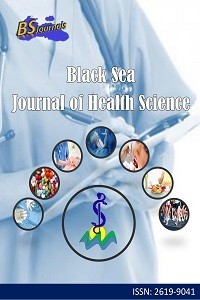Transient Atrioventricular Complete Block Rarely Detected in a Patient with COVID-19: A Case Report
Transient Atrioventricular Complete Block Rarely Detected in a Patient with COVID-19: A Case Report
COVID-19, Bradyarrhythmia, High-degree atrioventricular block, SARS-CoV-2, Atrioventricular complete block,
___
- Chinitz JS, Goyal R, Harding M, Veseli G, Gruberg L, Jadonath R, Maccaro P, Gandotra P, Ong L, Epstein LM. 2020. Bradyarrhythmias in patients with COVID-19: Marker of poor prognosis? Pacing Clin Electrophysiol, 43(10): 1199–1204.
- Garrott K, Kuzmiak-Glancy S, Wengrowski A, Zhang H, Rogers J, Kay MW. 2017. K (ATP) channel inhibition blunts electromechanical decline during hypoxia in left ventricular working rabbit hearts. J Physiol, 595(12): 3799–3813. https://doi.org/10.1113/JP273873.
- Huang C, Wang Y, Li X, Ren L, Zhao J, Hu Y, Zhang L, Fan G, Xu J, Gu X, Cheng Z, Yu T, Xia J, Wei Y, Wu W, Xie X, Yin W, Li H, Liu M, Cao B. 2020. Clinical features of patients infected with 2019 novel coronavirus in Wuhan, China. Lancet, 395(10223): 497–506. https://doi.org/10.1016/S0140-6736 (20)30183-5.
- Kir D, Mohan C, Sancassani R. 2020. Heart break: An unusual cardiac manifestation of COVID-19. JACC, 2(9): 1252–1255. https://doi.org/10.1016/j.jaccas.2020.04.026.
- Liu PP, Blet A, Smyth D, Li H. 2020. The Science Underlying COVID-19: Implications for the Cardiovascular System. Circulation, 142(1): 68–78. https://doi.org/10.1161/CIRCULATIONAHA.120.047549.
- Madjid M, Safavi-Naeini P, Solomon SD, Vardeny O. 2020. Potential Effects of Coronaviruses on the Cardiovascular System: A Review. JAMA Cardiol, 5(7): 831–840. https://doi.org/10.1001/jamacardio.2020.1286.
- Ronco C, Reis T. 2020. Kidney involvement in COVID-19 and rationale for extracorporeal therapies. Nature Reviews. Nephrol, 16(6): 308–310. https://doi.org/10.1038/s41581-020-0284-7.
- Vetter P, Vu DL, L’Huillier AG, Schibler M, Kaiser L, Jacquerioz F. 2020. Clinical features of covid-19. BMJ, 369: 1470. https://doi.org/10.1136/bmj.m1470.
- Wang D, Hu B, Hu C, Zhu F, Liu X, Zhang J, Wang B, Xiang H, Cheng Z, Xiong Y, Zhao Y, Li Y, Wang X, Peng Z. 2020. Clinical characteristics of 138 hospitalized patients with 2019 novel coronavirus-infected pneumonia in Wuhan, China. JAMA, 323(11): 1061–1069. https://doi.org/10.1001/jama.2020.1585.
- Wang Y, Wang Z, Tse G, Zhang L, Wan EY, Guo Y, Lip GYH, Li G, Lu Z, Liu T. 2020. Cardiac arrhythmias in patients with COVID-19. J Arrhythmia, 36(5): 827–836. https://doi.org/10.1002/joa3.12405.
- Zhou P, Yang XL, Wang XG, Hu B, Zhang L, Zhang W, Si HR, Zhu Y, Li B, Huang CL, Chen HD, Chen J, Luo Y, Guo H, Jiang RD, Liu MQ, Chen Y, Shen XR, Wang X, Shi ZL. 2020. A pneumonia outbreak associated with a new coronavirus of probable bat origin. Nature, 579(7798): 270–273. https://doi.org/10.1038/s41586-020-2012-7.
- Yayın Aralığı: Yılda 4 Sayı
- Başlangıç: 2018
- Yayıncı: Cem TIRINK
The Relationship of Personality Traits on the Levels of Anxiety and Depression During Pregnancy
Orthodontic-Surgical Treatment of a Skeletal Class II Malocclusion: A Case Report
Aylin KAYADÜĞÜN, Muhammed Hilmi BUYUKCAVUS, Yavuz FINDIK, Timuçin BAYKUL
COVID-19 Pandemisinde Yoğun Bakım Hastalarında Basınç Yaralanmaları
Bilge TEZCAN, Şule ALPAR ECEVİT
Kedi Isırığı Sonrası Yumuşak Doku Enfeksiyonu
Servan VURUCU, Sevil ALKAN, Anıl AKÇA, Taylan ÖNDER, Cihan YÜKSEL, Safiye Bilge GÜÇLÜ KAYTA
Transient Atrioventricular Complete Block Rarely Detected in a Patient with COVID-19: A Case Report
Murat DUYAN, Serhat GÜNLÜ, Ali SARIDAŞ, Yıldızhan SOLAÇ, Mehmet DURGUN
Nadir Postauriküler Pilonidal Sinüs Olgusu
Fatmanur SÖKÜCÜ, Sedat YİĞİT, Emine PEKTAŞ, Hatice MUTLU ALBAYRAK, Peren PERK YÜCEL, Serkan USGU, Yavuz YAKUT
Obezitede Akdeniz Diyetinin Bağırsak Mikrobiyotasına Etkisi ve Kilo Vermeye Yansımaları
Alper TOKAY, Şadiye KIVRAKDAL, Büşra KAYALARLI, Aleyna ARTAR, Şennur GANİMET
